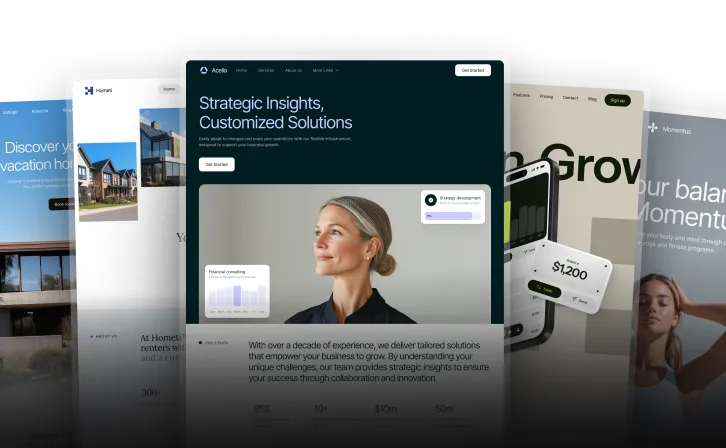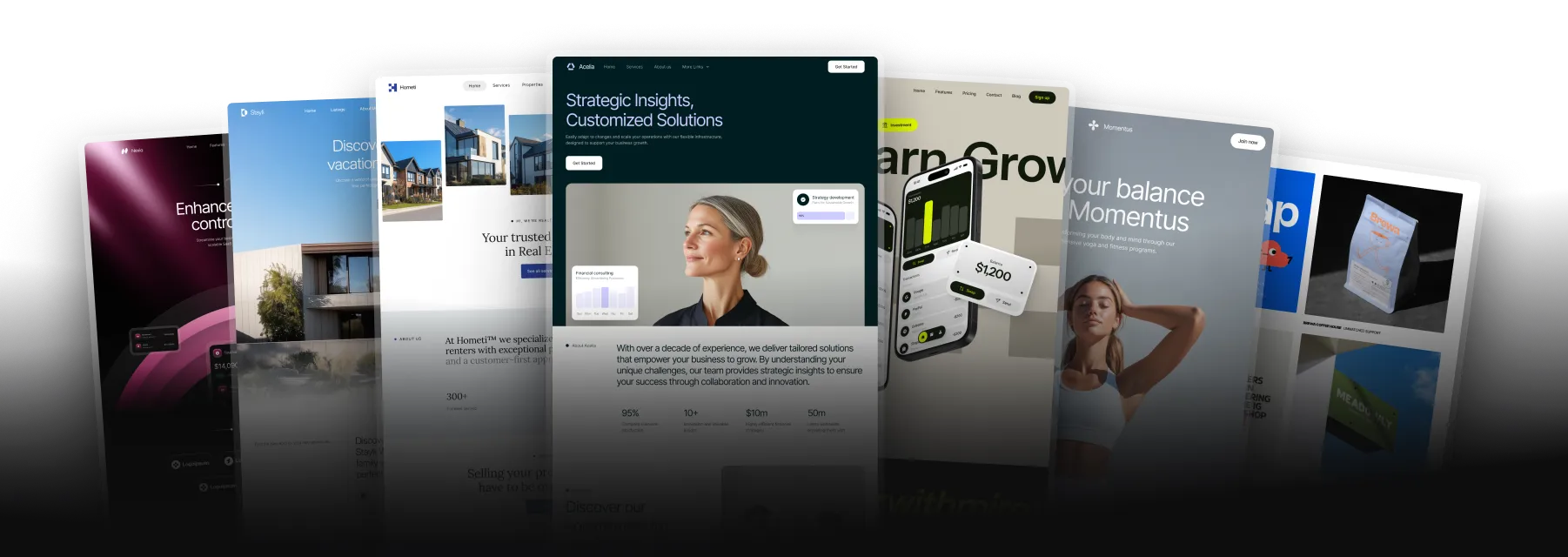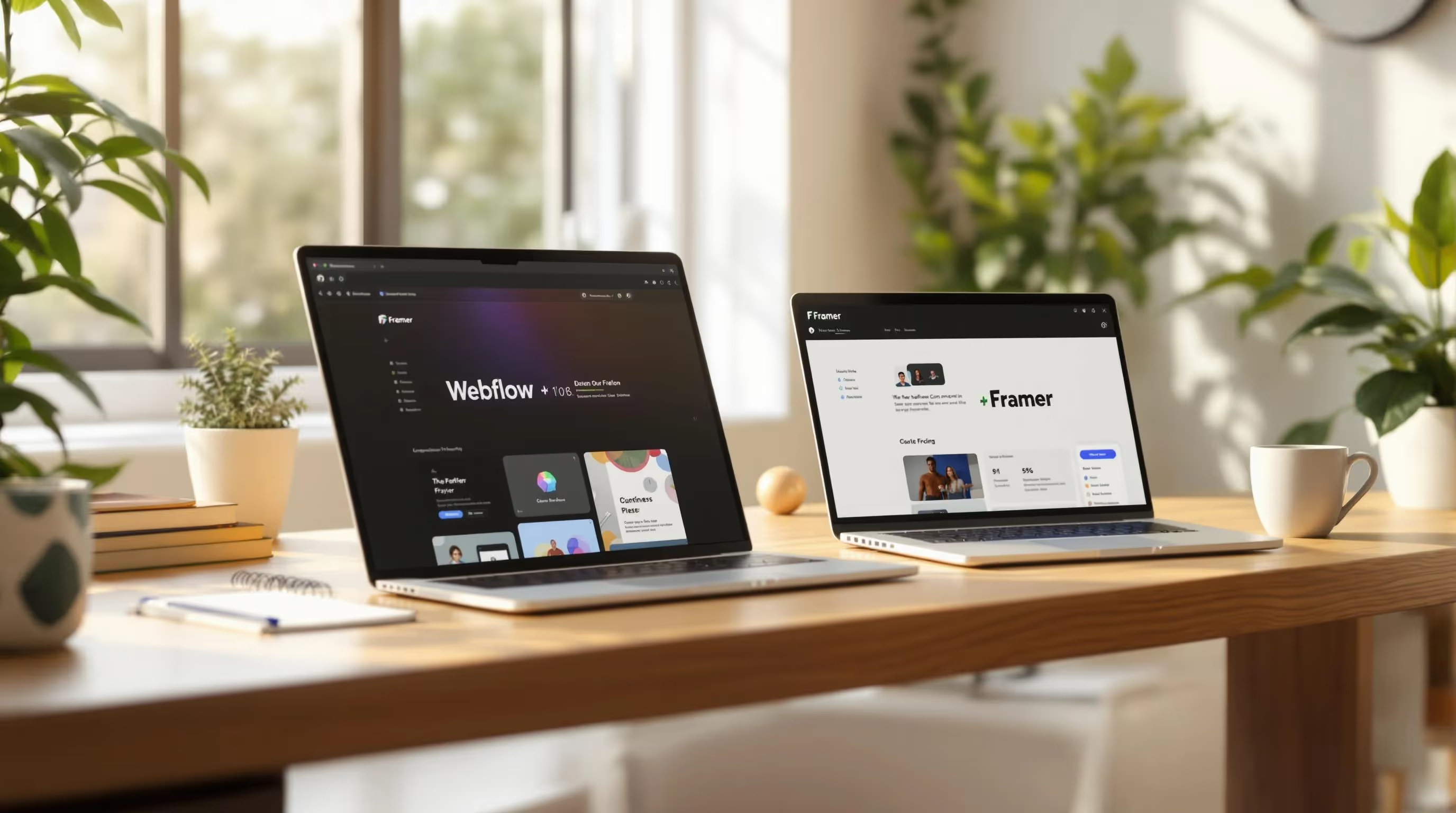Webflow vs Framer: Choosing the Right Platform in 2025
Unlock all templates




Looking for the best no-code website builder in 2025? Here’s a quick breakdown of Webflow and Framer to help you decide:
- Webflow: Ideal for developers and businesses needing advanced customization, CMS features, and e-commerce tools. It’s powerful but comes with a steeper learning curve. Pricing starts at $14/month.
- Framer: Perfect for designers and startups focused on visually stunning, interactive websites. It’s user-friendly, with quick setup but fewer advanced options. Pricing starts at $15/month.
Quick Comparison
| Feature | Webflow | Framer |
|---|---|---|
| Primary Users | Developers & Enterprise | Designers & Startups |
| Learning Curve | Steeper, more complex | Easier, faster adoption |
| Design Focus | Advanced layouts, CMS | Interactive, animations |
| Starting Price | $14/month (Basic plan) | $15/month (Basic plan) |
| E-commerce | Built-in tools | Not available |
| CMS Capabilities | 16 field types, 20,000 items | 12 field types, 30,000 pages |
Key takeaway: Choose Webflow for complex, scalable projects. Opt for Framer if speed and design simplicity are your priorities.
Design Interface and Tools
How Webflow Works

Webflow offers professional-grade tools paired with a visual design interface. Its side-aligned design controls and visual CSS editor make it easy to fine-tune typography and spacing. One standout feature is its class-based system, which lets you create reusable styles that instantly update across all linked elements. The platform also integrates a content management system directly with its design tools, making it simple to build dynamic content. Plus, it includes built-in features for SEO and responsive design.
How Framer Works

Framer provides a free-form canvas, which will feel familiar to anyone who has used Figma. Its contextual "fly-around" controls minimize clutter, creating a smoother design experience. Framer excels in animations, enabling interactive elements and transitions without requiring much coding. Since 2025, Framer has expanded its AI tools, introducing features like AI Styles for quick design variations, AI Photo Generation for custom images, and smart editing tools for fast adjustments. These tools highlight Framer's focus on simplicity and creativity.
Ease of Use Comparison
Webflow and Framer target different user needs. Webflow is ideal for creating SEO-rich, complex websites, but it comes with a steeper learning curve. On the other hand, Framer's design-first approach allows for faster website creation, often cutting project timelines from five days to just two for non-technical users. Webflow supports beginners with extensive training resources through Webflow University, while Framer's intuitive interface makes it easy to dive in without much prior experience, though it offers fewer in-depth customization options. Choosing between the two depends on whether you value detailed control or a faster, more interactive design workflow.
Technical Features
Webflow Development Options
Webflow offers a powerful CMS and extensive customization options, making it ideal for creating complex, dynamic websites. Its CMS supports 16 field types, such as multi-reference and video fields. On the Business plan ($124/month), you can manage up to 20,000 CMS items. With over 240 apps in its app store, Webflow provides a wide range of integrations. Its v2 API gives detailed access to collections, fields, and items, allowing for advanced functionality. For performance, Webflow includes built-in JavaScript minification and supports deep customization of components, including animations and state management.
Framer Development Options
Framer expanded its CMS in 2025 with a Scaleup plan that supports up to 30,000 pages. The platform introduced its plugin marketplace in 2024, which now includes 100 plugins designed to enhance functionality. Framer's CMS interface is modern and easy to use, focusing on simplicity and user experience. It supports 12 field types and includes a streamlined rich text editor. However, it lacks certain advanced options like code embeds, which are available in Webflow. Below is a comparison of key technical features between Webflow and Framer.
Technical Capabilities Compared
| Feature | Webflow | Framer |
|---|---|---|
| CMS Field Types | 16 types including multi-reference | 12 types |
| Page Limit (Business/Scaleup) | 20,000 items | 30,000 pages |
| Plugin Ecosystem | 240+ apps | 100 plugins |
| Component Management | Single component with all states | Separate component per state |
| Rich Text Support | Full HTML support with code embeds | User-friendly but limited embeds |
| Animation Control | Extensive customization | Basic preset options |
Webflow integrates with over 5,000 apps via Zapier, including popular tools like HubSpot, Mailchimp, and Slack. While Framer provides a more streamlined and intuitive design environment, it doesn't offer the same level of granular control as Webflow. This makes Webflow a better fit for projects that require advanced customization.
Webflow vs Framer: Key Differences and Pricing Explained (2025)
sbb-itb-fdf3c56
Cost Analysis
When deciding between platforms, pricing plays a key role in determining value and project fit. Let’s break down the cost structures of Webflow and Framer to see how they align with different needs.
Webflow Plans and Costs
Webflow’s pricing is divided into Site plans (for building and hosting websites) and Workspace plans (for team collaboration). These are billed annually:
-
Site Plans:
- Basic: $14/month
- CMS: $23/month
- Business: $39/month
- E-commerce: Ranges from $29 to $212/month, scaling based on sales volume.
-
Workspace Plans:
- Freelancer: $16/month
- Team: $19/month
- Enterprise: Custom pricing available.
Webflow’s structure offers flexibility for both individual creators and larger teams.
Framer Plans and Costs
Framer uses a simpler, site-based billing model. Individual site plans include:
- Mini: $5/month
- Basic: $15/month
- Pro: $30/month
For teams or larger projects, Framer provides the following options:
| Plan | Monthly Cost (Billed Annually) | Key Features |
|---|---|---|
| Startup | $75 | Up to 10 CMS collections, 200,000 monthly visitors |
| Scaleup | $200 | 30,000 pages, unlimited translations |
| Enterprise | Custom pricing | Custom security features, dedicated support |
Additional editors cost $40 per month, based on the workspace’s highest-tier plan. Framer’s pricing is tailored for smaller teams and simpler projects.
Price Comparison by Project Type
How do these platforms stack up for different project types?
-
Portfolio Sites:
Webflow’s $39/month Business plan supports 10,000 CMS items, 400 GB bandwidth, and 300,000 visitors. Framer’s $30/month Pro plan includes basic features but is limited to about 100 GB bandwidth and 200,000 visitors. -
E-commerce Projects:
Webflow has built-in e-commerce functionality starting at $29/month. Framer, as of 2025, does not offer native e-commerce features. -
SaaS and Team Projects:
Webflow’s $39/month Business plan offers advanced CMS capabilities for teams. Framer’s Startup plan starts at $75/month, with an additional $40 per editor, making it more expensive for collaborative projects.
Each platform’s pricing structure reflects its target audience, whether individual creators, small teams, or larger-scale projects.
Best Uses for Each Platform
Choosing the right platform depends on the type of project you're working on. Here's a breakdown of how Webflow and Framer excel in different scenarios.
When to Use Webflow
Webflow stands out for projects that require advanced features and scalability. It's a great fit for:
-
Business and Marketing Sites
Webflow's CMS and customization options are perfect for creating dynamic marketing sites. Its backend tools support projects that can grow alongside your business. -
Complex CMS-Driven Websites
If you're managing content-heavy sites like multi-author blogs, resource hubs, or portfolio directories, Webflow's CMS capabilities make it a strong choice.
When to Use Framer
Framer is ideal for projects where speed and design take priority. It's best suited for:
-
Design-First Projects
Framer’s focus on visual design makes it perfect for personal portfolios, agency showcases, brand microsites, and landing pages. It’s geared toward creating striking designs with minimal coding. -
Small Team Collaborations
With an interface similar to Figma, Framer is easy for small teams to use when prototyping or building simple, visually impactful websites.
Project Type Comparison
Here’s a side-by-side look at which platform works better for specific project needs:
| Project Type | Better Choice | Key Advantage |
|---|---|---|
| SaaS Marketing | Webflow | Advanced integrations |
| Portfolio Sites | Framer | Quick setup |
| E-commerce | Webflow | Built-in commerce |
| Landing Pages | Framer | Rapid deployment |
| Content-Heavy Sites | Webflow | Powerful CMS |
| Design Prototypes | Framer | Fast iteration |
Making Your Choice
Main Platform Differences
Webflow provides extensive customization and control for those with technical knowledge, while Framer focuses on quick, design-first workflows.
| Aspect | Webflow | Framer |
|---|---|---|
| Learning Curve | Steep; ideal for users familiar with HTML/CSS | Easy to pick up; interface similar to Figma |
| Development Focus | Full-featured website creation | Prioritizes design-first workflows |
| Project Complexity | Great for detailed, feature-rich sites | Best for simple, visually focused sites |
| Price | $14–$39/month (annual billing) | $5–$30/month (annual billing) |
These distinctions can help you zero in on the platform that matches your project goals.
Platform Selection Guide
Your choice should align with your skills and project requirements:
Webflow is ideal if you need:
- A powerful CMS for managing intricate content
- Advanced customization and third-party integrations
- E-commerce capabilities
Framer is perfect if you want:
- A fast way to create visually appealing designs
- A design interface similar to Figma
- AI tools to explore design variations
Looking Ahead
As these platforms evolve, think about how their updates might affect your long-term plans. Webflow, with over 720,000 websites, is a well-established option, while Framer's 70,000+ sites signal its growing popularity. By 2025, Webflow plans to enhance its CMS tools for marketing teams, and Framer is expanding its AI-based features. Both platforms offer free plans, so testing them out can help you make a confident decision.
For a head start, you can explore premium templates from Temlis, priced between $79 and $129, to streamline your project setup - no matter which platform you choose.
Related Blog Posts
Recommended posts
Unlock all templates







